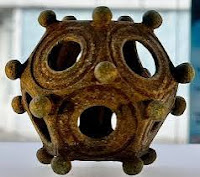Revealing the secret of the Roman dodecahedron
Scattered across the vast expanses of the Roman Empire, an amazing artifact has puzzled archaeologists for a long time - the Roman dodecahedron. These enigmatic objects, made of bronze or stone, have 12 pentagonal faces decorated with knobs and holes of various sizes. Their mysterious nature has given rise to numerous theories about their purpose, ranging from ordinary tools to sacred tools.
Excavations of the Roman dodecahedron:
The geographical distribution of the Roman dodecahedron shows the scale of the Roman Empire, with examples found in Britain, Germany, France and beyond. Their common appearance suggests widespread familiarity and recognized importance in Roman society. Interestingly, these artifacts are mostly concentrated in the northwestern provinces, indicating a regional purpose or production.
Archaeological theories: Revealing the purpose of the dodecahedron:
The enigmatic nature of the Roman dodecahedron has sparked a lively debate among archaeologists, each of whom has put forward their own theory to unravel its purpose. Some suggest a utilitarian role, envisioning them as measuring tools, game pieces, or even navigation aids. Others delve into the realm of symbolism and religion, suggesting they be used as offerings, talismans, or divination tools.
The Roman dodecahedron is a testament to the ingenuity and skill of the ancient Romans. While its exact purpose remains elusive, the sheer number and widespread distribution of these artifacts underscores their importance to Roman society. With the advent of new discoveries and the development of archaeological interpretations, the riddle of the Roman dodecahedron may one day reveal its secrets, offering a deeper insight into the lives and practices of our ancient ancestors.




Comments
Post a Comment